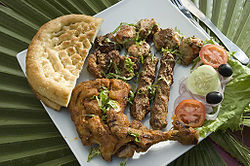Tikka (food)
 From Wikipedia - Reading time: 8 min
From Wikipedia - Reading time: 8 min
 Paneer Tikka served in a restaurant in Mumbai, India. | |
| Course | Hors d'oeuvre |
|---|---|
| Region or state | Indian Subcontinent |
| Serving temperature | Hot |
| Main ingredients | Meat, paneer, marinade, yogurt, spices or curry |
| Variations | Chicken Tikka Masala, Paneer Tikka Masala |
Tikka (pronounced [ʈɪkkaː]) is a dish consisting of pieces of meat or vegetarian alternatives whose origins are traced back to ancient Babylon. The term 'tikka' was given in the Mughal era.[1][2] It is made by marinating the pieces in spices and yogurt, and cooking them in a tandoor. Tikka is popular throughout the Indian subcontinent and also in the United Kingdom.
Etymology
[edit]Tikka is a Chaghatai word which has been commonly combined with the Hindi-Urdu word masala — itself derived from Arabic — with the combined word originating from British English.[1][2] The Chaghatai word tikka itself is a derivation of the Common Turkic word tikkü, which means "piece" or "chunk".[3][4]
Origin
[edit]The precise origin of the dish is uncertain. Recipes for cooked meat enriched with spices and mixed within a sauce date back to 1700 BCE found on cuneiform tablets near Babylon, credited to the Sumerians.[5] During the Mughal dynasty, the Mughals called "boneless pieces of cooked meat" Tikka.[6]
There are different varieties of the dish, both meat inclusive and vegetarian. Generally, the dish is defined as "a dish of small pieces of meat or vegetables marinated in a spice mixture".[7]
Preparation
[edit]Tikka consists of boneless pieces of meat or vegetarian alternatives such as paneer, which are marinated in spices and yogurt and subsequently strung through a skewer to be cooked.[3] It is generally cooked in a tandoor and served dry.[3]
Variations
[edit]Indian-subcontinent variations
[edit]The Indian variations of Tikka are the roots of the Western variations, including Chicken tikka and Paneer tikka, which are generally served dry.
Cross-cultural variations
[edit]Regular chicken and paneer tikka have been combined with dishes from other cultures such as Mexican cuisine to create hybrid dishes such as Tikka Masala Burritos, which are served with either chicken or paneer as their main ingredient.[8]
Popularity
[edit]In Britain
[edit]A study was undertaken in the 1990s that revealed British interest in foreign food, with chicken tikka being a favourite filling in the British Rail sandwich.[9]
In India
[edit]A study of 670 foreign tourists at Indira Gandhi International Airport, New Delhi, attempted to show the street food preferences of foreign tourists in the city, along with the reason for their selection. Of the 17 most preferred street foods, chicken tikka was the most favoured, with tourists preferring mildly flavoured foods that are hygienically prepared.[10]
During the cricket World Cup in 2018, restaurants in the host city served dishes named after cricket players using cricket terminology.[11] For instance, paneer tikka was renamed Dhoni da Tikka after former Indian cricket captain Mahendra Singh Dhoni and chicken tikka was renamed Virat's Straight Drive after Indian cricket captain Virat Kohli.[11]
Preservation and quality
[edit]Paneer tikka
[edit]Paneer tikka has a shelf-life of 1–2 days, which can be increased to 28 days using modified atmosphere packaging (MAP) technology.[12] Vacuum packaging is most effective as it is able to limit chemical changes during storage, increasing the refrigerated shelf-life of paneer tikka to 40 days.[13]
References
[edit]- ^ a b Maher, John C. (25 January 2022). Language Communities in Japan. Oxford University Press. p. 126. ISBN 978-0-19-885661-0.
Garamu masara (Eng. 'garam masala', originally Hindi-Urdu 'hot spices'), the term for a mixture of rika yamashita.
- ^ a b Kiaer, Jieun (2018). Translingual words : an East Asian lexical encounter with English. Milton: Routledge. p. 8. ISBN 978-1-351-10946-8. OCLC 1076808280.
- ^ a b c Ayto, John (2012). The Diner's Dictionary: Word Origins of Food & Drink (2nd ed.). Oxford: Oxford University Press. p. 371. ISBN 978-0-19-174443-3. OCLC 840919592.
- ^ Davidson, Alan (2014). Jaine, Tom (ed.). The Oxford Companion to Food. illustrations by Soun Vannithone (3rd ed.). New York: Oxford University Press. ISBN 978-0-19-967733-7. OCLC 890807357.
- ^ A postcolonial people : South Asians in Britain. Ali, N. (Nasreen), 1969–, Kalra, Virinder S., Sayyid, S. (Salman). London: Hurst & Co. 2006. p. 62. ISBN 1-85065-796-3. OCLC 70208358.
{{cite book}}: CS1 maint: others (link) - ^ Indigenous culture, education and globalization : critical perspectives from Asia. Xing, Jun,, Ng, Pak-sheung. Heidelberg. 23 October 2015. p. 130. ISBN 978-3-662-48159-2. OCLC 926915075.
{{cite book}}: CS1 maint: location missing publisher (link) CS1 maint: others (link) - ^ Concise Oxford English dictionary. Stevenson, Angus., Waite, Maurice. (12th ed.). Oxford: Oxford University Press. 2011. p. 1508. ISBN 978-0-19-960108-0. OCLC 692291307.
{{cite book}}: CS1 maint: others (link) - ^ Tanyeri, D (September 2018). "Fast-Casual Indian". Restaurant Development + Design. pp. 18–21.
- ^ James, A. (2013). Food, Health and Identity. Taylor & Francis. p. 71.
- ^ Gupta, Vikas; Khanna, Kavita; Gupta, Raj Kumar (1 January 2019). "Preferential analysis of street food amongst the foreign tourists: a case of Delhi region". International Journal of Tourism Cities. 6 (3): 511–528. doi:10.1108/IJTC-07-2018-0054. ISSN 2056-5607. S2CID 202197790.
- ^ a b Tahseen, I. (11 May 2018). "Virat chicken tikka ya Afridi kebab?". The Times of India.
- ^ Sharma, M. (June 2016). "Shelf Life Enhancement of Paneer tikka by Modified Atmospheric Packaging". Journal of Pure and Applied Microbiology. 10 (2): 1415–1420.
- ^ Ahuja, Kunal K.; Goyal, G. K. (June 2013). "Combined effect of vacuum packaging and refrigerated storage on the chemical quality of paneer tikka". Journal of Food Science and Technology. 50 (3): 620–623. doi:10.1007/s13197-012-0688-x. ISSN 0022-1155. PMC 3602555. PMID 24425964.
 KSF
KSF